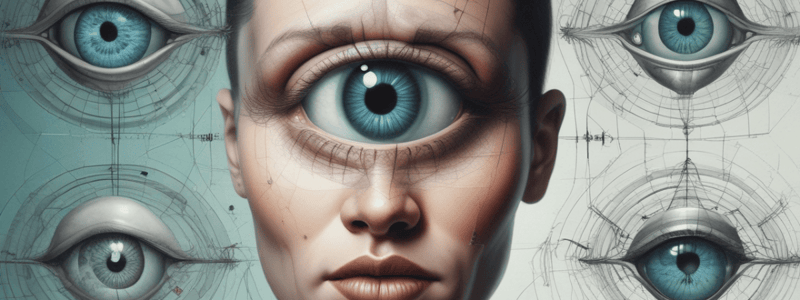Podcast
Questions and Answers
Сопоставьте типы аберраций с их описанием:
Сопоставьте типы аберраций с их описанием:
Сферическая аберрация = Искажения изображения на сетчатке из-за формы роговицы и линзы Астигматизм = Изображение на сетчатке точечного источника света выглядит как линия из-за неправильной сферичности роговицы и линзы Хроматическая аберрация = Различные цвета фокусируются в разных точках из-за различных показателей преломления света на разных длинах волн Рассеяние = Фактор, влияющий на качество изображения на сетчатке из-за несовершенства оптических свойств глаза
Сопоставьте определения со следующими терминами:
Сопоставьте определения со следующими терминами:
Стекловидное тело = Прозрачное желеобразное вещество, заполняющее пространство между хрусталиком и сетчаткой Интраокулярные линзы = Искусственные линзы, используемые в хирургии катаракты для замены естественного хрусталика Оптические свойства глаза = Несовершенства, влияющие на качество образа на сетчатке, такие как аберрации и рассеяние Рефрактивный индекс = Числовая характеристика преломляющей способности материала, определяющая скорость света в этом материале
Соотнесите следующие понятия с их описанием:
Соотнесите следующие понятия с их описанием:
Витреозный гумор = Помогает поддерживать форму глаза и поддерживает хрусталик Оптическое проектирование интраокулярных линз = Активное направление исследований, которое может привести к улучшению клинических результатов Дифракция = Фактор, влияющий на качество образа на сетчатке из-за несовершенств оптических свойств глаза Формирование изображения на сетчатке = Неидеальные оптические свойства глаза могут вызвать искажения образа на сетчатке
Подберите определения к следующим понятиям:
Подберите определения к следующим понятиям:
Установите соответствие между определениями и следующими терминами:
Установите соответствие между определениями и следующими терминами:
Flashcards are hidden until you start studying
Study Notes
Optical Properties of the Eye
The optical properties of the eye play a crucial role in our ability to see the world around us. The human eye is a marvel of nature, consisting of a series of refractive surfaces that work together to form a sharp image on the retina. In this article, we will explore the optical properties of the eye, focusing on the refractive surfaces and how they contribute to the overall function of the eye.
Refractive Surfaces
The eye's refractive surfaces include the cornea, the crystalline lens, and the vitreous humor. These surfaces work together to bend light rays and focus them onto the retina, which is the light-sensitive tissue at the back of the eye.
Cornea
The cornea is the transparent outer layer of the eye, responsible for 70% of the eye's refractive power. It is approximately a spherical section with an anterior radius of curvature of 7.8 mm, posterior radius of curvature of 6.5 mm, and a refractive index of 1.3771. The cornea's refractive index is higher than that of the surrounding media, causing it to act as a lens that focuses light onto the retina.
Crystalline Lens
The crystalline lens is a biconvex lens located behind the cornea. It has radii of curvature of 10.2 and −6.0 mm for the anterior and posterior surfaces, respectively. The internal structure of the lens is layered, with a higher refractive index in the center and a lower refractive index in the periphery. This refractive index gradient helps to focus light onto the retina.
Vitreous Humor
The vitreous humor is a clear, gel-like substance that fills the space between the crystalline lens and the retina. It has a refractive index of 1.336, similar to that of water. The vitreous humor helps to maintain the shape of the eye and supports the crystalline lens.
Optical Properties and Aberrations
The optical properties of the eye are not perfect, and several factors can affect the quality of the image formed on the retina. These factors include scattering, diffraction, and aberrations.
Aberrations
Aberrations are distortions in the image formed on the retina due to imperfections in the refractive surfaces of the eye. There are several types of aberrations, including:
- Spherical Aberration: This occurs due to the shape of the cornea and lens, causing light rays at the edge of the lens to focus at a different point than those in the center.
- Astigmatism: This occurs when the cornea and lens are not perfectly spherical, causing the retinal image of a point source to be a line rather than a point.
- Chromatic Aberration: This occurs due to the different refractive indices of light at different wavelengths, causing different colors to focus at different points.
Optical Design of Intraocular Lenses
Intraocular lenses (IOLs) are artificial lenses used in cataract surgery. They are designed to replace the natural crystalline lens and restore visual function. The optical design of IOLs is a highly active field of research, as the study and modeling of these lenses can lead to improved clinical outcomes.
In conclusion, the optical properties of the eye are essential for our ability to see the world around us. The combination of the cornea, crystalline lens, and vitreous humor works together to focus light onto the retina, and the eye's optical design is a topic of ongoing research. Understanding the optical properties of the eye and their potential imperfections can help in the development of improved optical devices and treatments for vision disorders.
Studying That Suits You
Use AI to generate personalized quizzes and flashcards to suit your learning preferences.



